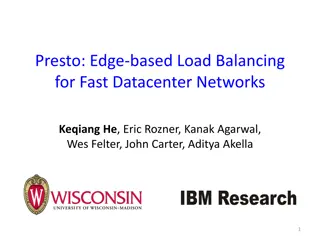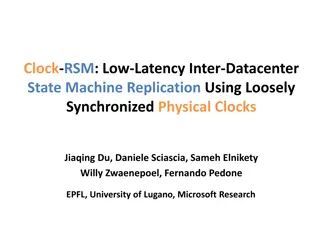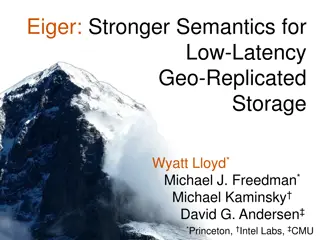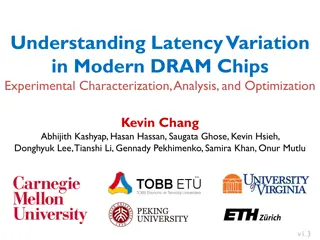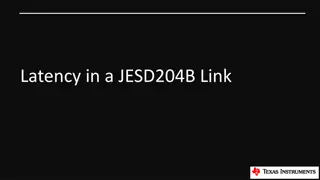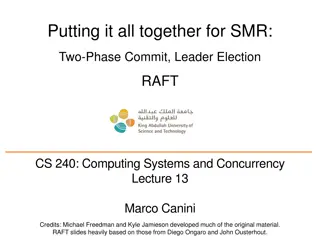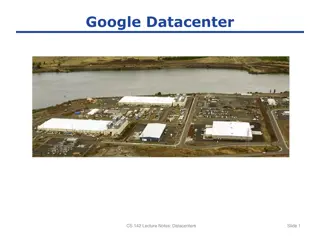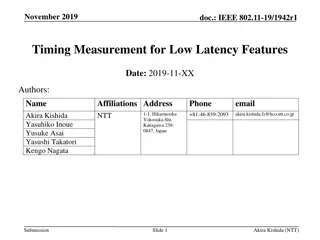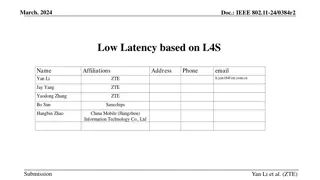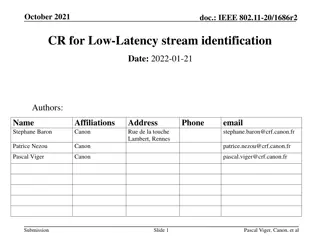Low-Latency Multi-Datacenter Databases Using Replicated Commit
This study explores low-latency multi-datacenter databases utilizing replicated commit techniques. The main contributions involve reducing cross-data center communication trips and comparing replicated commit with replicated log. An extensive experimental evaluation was conducted considering various factors like the number of data centers involved, read vs. write operations, and more, to assess the effectiveness of the approach.
Uploaded on Mar 08, 2025 | 1 Views
Download Presentation

Please find below an Image/Link to download the presentation.
The content on the website is provided AS IS for your information and personal use only. It may not be sold, licensed, or shared on other websites without obtaining consent from the author.If you encounter any issues during the download, it is possible that the publisher has removed the file from their server.
You are allowed to download the files provided on this website for personal or commercial use, subject to the condition that they are used lawfully. All files are the property of their respective owners.
The content on the website is provided AS IS for your information and personal use only. It may not be sold, licensed, or shared on other websites without obtaining consent from the author.
E N D
Presentation Transcript
Low-Latency Multi-Datacenter Databases using Replicated Commit Hatem Mahmoud, Faisal Nawab, Alexander Pucher, Divyakant Agrawal, Amr El Abbadi UCSB Presented by Ashutosh Dhekne
Main Contributions Reduce cross data center communication trips Compare Replicated Commit with Replicated Log Extensive experimental study for evaluation of the approach Number of data centers involved Read vs Write operations Number of operations per transaction Data objects in the database Effect of used shards
2 Phase Commit Coordinator Worker1 Worker2 Worker3 Do Work Prepare Y Ready Y Y Do Commit Y Y Y Complete
Why merge 2PC and Paxos? Two phase commit is very good for reaching consensus Agreement is guaranteed only coordinator decides Validity is guaranteed commit happens only if everyone is ready. Termination is guaranteed no loops possible But Failures can wreak havoc Paxos is good even if failures occur quorum based, majority wins
Replicated Log Step by Step Client X Y Z X Y Z X Y Z Paxos Data Transaction Datacenter 1 Datacenter 2 Datacenter 3
Replicated Log Step by Step Client X Y Z X Y Z X Y Z 2PC Prepare message to Paxos Leaders Datacenter 1 Datacenter 2 Datacenter 3
Replicated Log Step by Step Client X Y Z X Y Z X Y Z Acquire exclusive locks and log 2PC Prepare locally Datacenter 1 Datacenter 2 Datacenter 3
Replicated Log Step by Step Client X Y Z X Y Z X Y Z Leader informs same shard in other datacenters Those shards reply accept Datacenter 1 Datacenter 2 Datacenter 3
Replicated Log Step by Step Client X Y Z X Y Z X Y Z All of those messages together Datacenter 1 Datacenter 2 Datacenter 3
Replicated Log Step by Step Client X Y Z X Y Z X Y Z Paxos leaders know status of their shards in other data centers Paxos leaders ack the coordinator that they are ready Y Y Datacenter 1 Datacenter 2 Datacenter 3
Replicated Log Step by Step Client X Y Z X Y Z X Y Z Y Y Coordinator can now log commit Then asks it s peer shards to commit and receives acks Datacenter 1 Datacenter 2 Datacenter 3
Replicated Log Step by Step Client X Y Z X Y Z X Y Z Coordinator releases lock Informs other leaders that commit is made Datacenter 1 Datacenter 2 Datacenter 3
Replicated Log Step by Step Client X Y Z X Y Z X Y Z Other leaders go in another frenzy to intimate their shards on other data centers Finally, locks are released Datacenter 1 Datacenter 2 Datacenter 3
Replicated Commit Step by Step Client X Y Z X Y Z X Y Z Paxos accept request to coordinators Datacenter 1 Datacenter 2 Datacenter 3
Replicated Commit Step by Step Client X Y Z X Y Z X Y Z 2PC prepare message is sent to other shards locally Datacenter 1 Datacenter 2 Datacenter 3
Replicated Commit Step by Step Client X Y Z X Y Z X Y Z All acquire lock and log 2PC prepare message Datacenter 1 Datacenter 2 Datacenter 3
Replicated Commit Step by Step Client X Y Z X Y Z X Y Z All reply ready to the coordinator Datacenter 1 Datacenter 2 Datacenter 3
Replicated Commit Step by Step Client X Y Z X Y Z X Y Z All coordinators inform each other and the client. Client keeps quorum info Datacenter 1 Datacenter 2 Datacenter 3
Replicated Commit Step by Step Client X Y Z X Y Z X Y Z Commit is sent to all shards locally Datacenter 1 Datacenter 2 Datacenter 3
Replicated Commit Step by Step Client X Y Z X Y Z X Y Z Finally, locks are released Datacenter 1 Datacenter 2 Datacenter 3
Replicated Log Vs Replicated Commit Number of messages Replicated Log requires a lot of inter- datacenter message transfers Latency Network links across the continents are not at speed of light Access Locality Messages exchanged locally are very fast A solution to higher latency reduce the number of cross datacenter messages Replicated Commit achieves this
Experimental Setup 5 Data centers 2500 transactions 3000 items in the database, 1000 in each shard 3 shards per data center 50 operations per second in each datacenter
Average Commit Latency various datacenters Replicated Commit provides much faster responses than Replicated Logs Combination of servers from different regions versus combination of servers from same region has large impact
Scalability of Replicated Commit Replicated Commit has a very low read latency and comparable other latencies Replicated Commit supports many more clients than Replicated Log
Changing Database Properties Increasing number of data objects does not affect Replicated Commit latency Replicated Commit latency is agnostic of number of shards used
Fault Tolerance Sudden fault at one of the datacenters All clients are immediately served by another data center Latency increases in proportion Total latency for all clients gets affected possibly because of load Served by Ireland
Comments Comparison between SQL and NoSQL is missing Effect of individual shards failing What is the tradeoff between Replicated Logs and Replicated Commit? What are we losing if we adopt Replicated Commit? Why does everyone not use Replicated Commit? Comparisons with other techniques discussed in the related work could have bolstered the paper even further. Intra-datacenter and inter-datacenter protocols are different (physical location knowledge helps the protocol loss of abstraction)
Conclusion A modified approach to achieving ACID properties in multi-datacenter settings is discussed Gains with respect to Replicated Logs are proportional to the latency between the servers More processing is done locally inside a data-center and then consensus is reached
Fault Tolerant Logs Replica 1 Replica 2 Replica 3 Client App value Callback Callback Callback Submit Paxos Framework value value value






